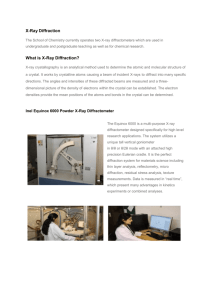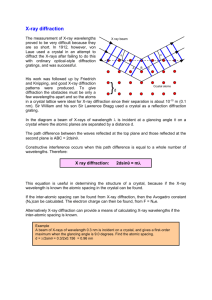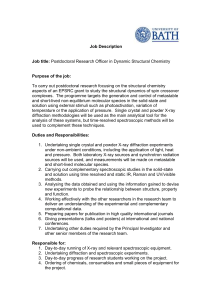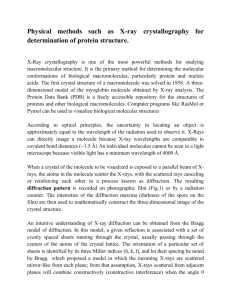China`s Efforts on Information Sharing of Science and Technology
advertisement
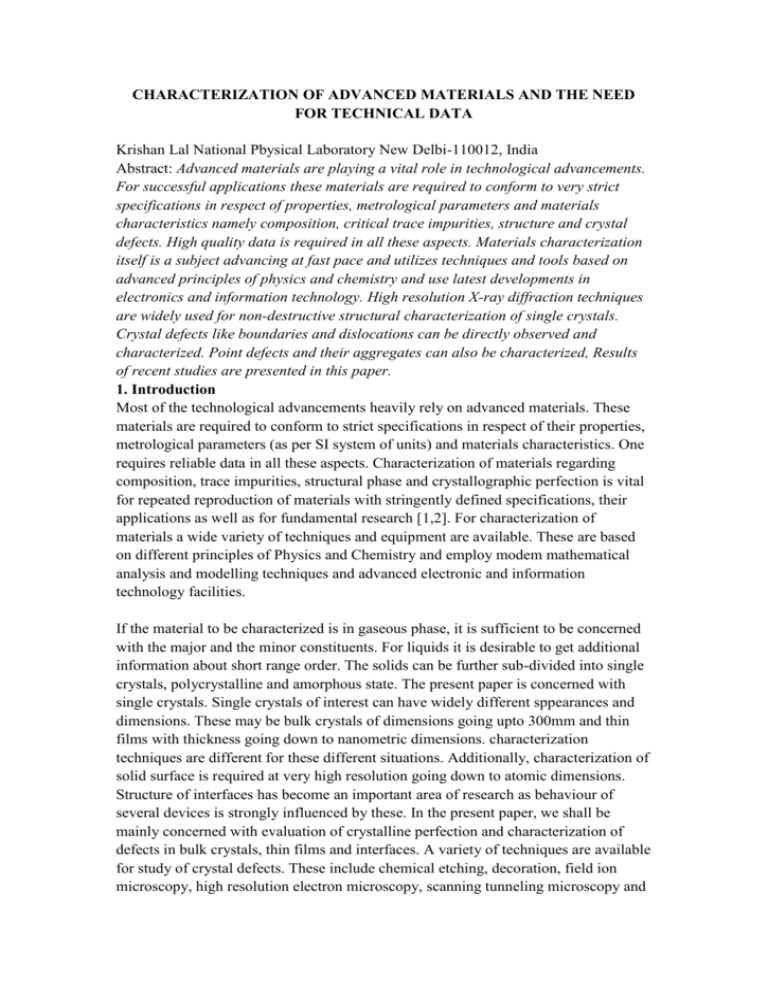
CHARACTERIZATION OF ADVANCED MATERIALS AND THE NEED
FOR TECHNICAL DATA
Krishan Lal National Pbysical Laboratory New Delbi-110012, India
Abstract: Advanced materials are playing a vital role in technological advancements.
For successful applications these materials are required to conform to very strict
specifications in respect of properties, metrological parameters and materials
characteristics namely composition, critical trace impurities, structure and crystal
defects. High quality data is required in all these aspects. Materials characterization
itself is a subject advancing at fast pace and utilizes techniques and tools based on
advanced principles of physics and chemistry and use latest developments in
electronics and information technology. High resolution X-ray diffraction techniques
are widely used for non-destructive structural characterization of single crystals.
Crystal defects like boundaries and dislocations can be directly observed and
characterized. Point defects and their aggregates can also be characterized, Results
of recent studies are presented in this paper.
1. Introduction
Most of the technological advancements heavily rely on advanced materials. These
materials are required to conform to strict specifications in respect of their properties,
metrological parameters (as per SI system of units) and materials characteristics. One
requires reliable data in all these aspects. Characterization of materials regarding
composition, trace impurities, structural phase and crystallographic perfection is vital
for repeated reproduction of materials with stringently defined specifications, their
applications as well as for fundamental research [1,2]. For characterization of
materials a wide variety of techniques and equipment are available. These are based
on different principles of Physics and Chemistry and employ modem mathematical
analysis and modelling techniques and advanced electronic and information
technology facilities.
If the material to be characterized is in gaseous phase, it is sufficient to be concerned
with the major and the minor constituents. For liquids it is desirable to get additional
information about short range order. The solids can be further sub-divided into single
crystals, polycrystalline and amorphous state. The present paper is concerned with
single crystals. Single crystals of interest can have widely different sppearances and
dimensions. These may be bulk crystals of dimensions going upto 300mm and thin
films with thickness going down to nanometric dimensions. characterization
techniques are different for these different situations. Additionally, characterization of
solid surface is required at very high resolution going down to atomic dimensions.
Structure of interfaces has become an important area of research as behaviour of
several devices is strongly influenced by these. In the present paper, we shall be
mainly concerned with evaluation of crystalline perfection and characterization of
defects in bulk crystals, thin films and interfaces. A variety of techniques are available
for study of crystal defects. These include chemical etching, decoration, field ion
microscopy, high resolution electron microscopy, scanning tunneling microscopy and
high resolution X-ray diffraction techniques includiong diffractometry, topography
and diffuse X-ray scattering or reciprocal lattice mapping as it is referred to in recent
literature. High resolution X-ray diffraction techniques[3] for investigation of crystals
including some important equipment and typical examples are presented.
Fig. 1 A schematic drawing showing diffraction of an absolutely parallel and
monochromated X-ray beam from a single crystal in Bragg geometry.
High Resolution X-ray Diffraction
When an absolutely parallel and monochromatic X-ray beam is diffracted from an
ideally perfect crystal, the characteristics of the diffracted beam are governed by the
dynamical theory of X-ray diffraction [4,5]. In the case of reflection geometry (Bragg
geometry, Fig. (1)) it is expected that the maximum intensity of diffraction from a
non-absorbing crystal will be 100%, i.e. the crystal is expected to behave like a
perfect mirror. The angular half width of the diffraction curve is given by the
following expression[4] :
¼��p>
Where re is the classical radius of electron ; λ is the wavelength of the radiation, F
H´ is the real part of the structure factor of the reflection under consideration, P is the
polarization factor; Vc is the volume of the unit cell and // B is the Bragg angle.
The value of the half width is less than 10 arc sec in most of the cases. Fig 2 shows a
typical theoretical diffraction curve for an ideally perfect silicon crystal. Its half width
is only 3.3 arc sec. One wishes to design experiments to achieve such curves in the
laboratory by comparing which with the theoretical curves the quality of crystals can
be evaluated. This method known as diffractometry is being widely employed for this
purpose. Also, topographic examination can give direct images of crystal defects. For
such experiments one requires an experimental arrangement which can provide a
nearly parallel and monochromatic beam of X-rays. The wavelength spread and the
divergence (also converted into angular scale) of the beam should be negligible in
comparison to the intrinsic half width for an ideal crystal. Multi-crystal X-ray
diffractometers have been developed for this purpose [3,5]. These use one or more
crystals to monochromate and collimate the exploring X-ray beam to the desired level.
In author`s laboratory, a series of multi-crystal X-ray diffractometers have been
developed whic include a Five Crystal X-ray Diffractometer with state-of-the-art level
resolution [3]. Salient features of this diffractometer are described in the following.
Fig 2. A theoretical diffraction curve of an ideally perfect silicon crystal.
A Five Crystal X-ray Diffractometer
Fig. 3 shows a schematic line diagram of the five-crystal X-ray diffractometer
designed and developed at the author`s laboratory. X-ray beam from a fine focus Xray source is mechanically collimated with the help of a long collimator fitted with a
fime slit. This beam is first diffracted from two plain silicon monochromatorcollimator crystals of Bonse-Hart type which are set in (+,-) configuration. The
diffracted beam consists of well resolved K\\ and K\\ components. The more intense
K\\ beam is isolated with the help of a fine slit and diffracted from the third
monochromator crystal oriented for diffraction in a highly dispersive setting. This
beam has its divergence much less than the intrinsic width of the K\\ characteristic
line. The specimen is generally the fourth crystal of the diffractometer and an analyzer
crystal forms the fifth crystal of the diffractometer. With this system, it is possible to
record diffraction curves of nearly perfect single crystals with half widths which are
within 10% of the theoretical widths expected under ideal conditions.
Fig.4 shows a typical diffraction curve of a silicon single crystal recorded on this
system [3]. This curve has a half width of 3.7 arc sec only. The theoretical value of
half width for these experimental conditions is 3.3 arc sec. Also, the curve shows a
nearly 100% reflectivity at the diffraction peak and a sloping top as expected for
crystals having finite absorption for X-rays. With this system, it is piossible to make
the following high resolution X-ray diffraction experiments : (i) diffractometery, (ii)
topography,(iii)diffuse X-ray scattering measurements (three axes),(iv) curvature
measurements to determine biaxial stress in thin films, (v) lattice parameter
measurements at ppm, level, (vi) measurements of lattice mismatch between epitaxial
films and single crystal substrates, (vii) accurate determination of crystallographic
orientation of surfaces of boules, disks and wafers, (viii) accurate determination of
orientation of flats (straight deges) on semiconductor wafers and (ix)direct
observation of dynamical diffraction features such as forward diffracted X-ray beem
and loss in absorption at diffraction maxima.
Fig. 3 A schematic diagram of the Five Crystal X-ray diffractometer developed in
author`s laboratory.
Characterization of Defects in Bulk Crystals, Thin Films and Interfaces
For determining degree of crystallographic perfection one required information about
the nature and concentration of defects. Major defects of concern are : grain
boundaries; sub-grain boundaries; dislocations and point defects and their clusters. By
using a combination of high resolution X-ray diffraction techniques, it is possible to
characterize all these defects. The grain boundaries manifest themselves as multiple
peaks in the diffraction curve and the large angular range extending over degrees of
arc over which the crystal diffracts. Since presence of grain boundaries indicates that
crystal is not a single crystal, we shall not deal with this. In any case, it is possible to
observe and characterize grain boundaries by using simple X-ray diffraction and other
techniques.
Fig. 4 A typical diffraction curve of a silicon single crystal recorded on the Five
Crystal X-ray Diffractometer
Low angle boundaries manifest as separate peaks in the diffraction curves of crystale
[6]. It is possible to orient the specimen at each peak and record topographs [6,7]. A
combination of diffractometry and topography helps in identifying the sub-grain and
also evaluate the perfection within the sub-grain. It is generally considered that the
angular misorientation between adjoining sub-grains are 1 arc min. However, recently
we have found that several crystals have low angle boundaries with angular
misorientation which are considerably lower than one min. of arc. For example,
diffraction curves of some BGO crystals indicate the presence of low angle
boundaries with a small angle of tilt of only 33 arc sec. However, the individual
curves are quite sharp with half width of ~ 9 arc sec only. Nearly perfect BGO
crystals are free of low angle boundaries, but have similar half width values[8].
Crystals free of grain boundaries and low angle boundaries and containing low
density of dislocations give single sharp diffraction peaks with half widths close to
theoretically expected values. High resolution X-ray diffraction topography can be
used to directly observe and characterize dislocations in such crystqals. Fig. 5 shows a
typical traverse topograph of GaAs crystal grown by horizontal Bridgman
technique[9]. In this topograph, three images of dislocations are clearly observed.
Each of these images is quite extended which shows the high sensitivity of this
technique. By recording similar topographs with different diffraction vectors it is
possible to characterize the dislocations as edge or a screw type. In this case, these are
edge dislocations. Several such examples are available in literature[10].
Fig.5 A typical high resolution traverse X-ray diffraction topograph of a nearly
perfect single crystal of gallium arsenide with only three dislocations
In crystals which are free of dislocations and boundaries, one is concerned with point
drfects and their clusters. At all finite temperatures. crystals are expected to contain
thermodynamically determined concentrations of point defects. In real crustals,
generally, thermodynamical equilibrium is not attained and point defects are far in
excess of the equilibrium value. This leads to clustering of point defects. We have
demonstrated that high resolution diffuse X-ray scattering measurements can be
profitably used to characterize point defeets and their clusters in otherwise nearly
perfect crystals[12]. In recent years, this technique has been enlarged and renamed ad
reciprocal lattice matching. A recent example of characterization of point defect
clusters in silicon crystals grown by two different techniques named Czochralski
method and the float zone method is presented here[13]. These crystals had very high
purity (10 k cm) and were free of dislocations. Their diffraction curves were quite
sharp and diffuse X-ray scattering were made very close to the diffraction maxima.
An analysis of the diffuse X-ray scattering distribution revealed that in the
Czochralski grown crystals interstitial clusters presumably due to unavoidable oxygen
impurity are responsible for the scattering. These could be modelled as dislocation
loops with dimensions of ~0.8\\m. In the case of float zone crystals, the predominant
defects were vacancy clusters in the shape of platelets lying on {111} planes and
having sizes of ~ 0.6\\m.
It is possible to characterize epitaxial films by using high resolution X-ray diffraction
techniques. Generally, one gets separate peaks due to the film and the substrate. One
can use diffractometric and topographic characterization for evaluating the perfection
of the film as well as the substrate(interface). Fig. 6 shows a typical diffraction curve
of gallium antimonide film grown on GaAs substrate. There is a substantial angular
difference in the peak position of the two curves. Generally, the observed angular
difference is regarded due to lattice mismatch bettween the film and the substrate.
However, there is an additional mismatch due to a difference in the crystallographic
orientation of the film and the substrate. This difference is also very important and
sometimes can be substantial. By using the analyzer crystal. it is possible to
quantitatively determine the two mismatches separately. In this series of films, both
the lattice mismatch and the orientational mismatch were substantial. Even in films
prepared by MBE, the orientational mismatch is a significant fraction of the total
observed angular difference. From the value of Ad/d, the composition of the film can
be determined accurately. Perfection of the films and interface region is determined
from the shapes of the diffraction curves and the contrast in topographs.
An interesting application of high resolution X-ray diffraction techniques is concerned
with determination of biaxial stress in thin film deposits on single crystal substrates.
The stress leads to bending of the substrates which can be measured from the
observed change in the orientation of the diffraction vector across a wafer as a
function of linear movement [9]. By combining these curvature measurements with
diffractometry and topography, one can directly observe the distribution of stress as
well as the effect of stress on crystallographic perfection of the substrate. In a recent
investigation, we have studied molybdenum silicide films on silicon single crystal
substrates[14]. In this as well as in our previous investigations, we have observed that
it is very important to take into account the bending of the starting wafer. No wafer is
absolutely flat. If the bending is not taken into account, not only the value of stress
will be wrong but also the sense of the stress may go wrong. For example, Fig. 7
shows a curvature plot of MoSi\\ film on silicon wafer. It is seen that the wafer was
convex shaped when viewed from the polished side. Deposition of film changed its
curvature drastically and it became concave in shape. After rapid thermal annealing, it
again regained its shape but with much higher radius of curvature. In this
investigation, it was shown that the effect of bending of initial wafer on the final value
of stress is very high. By careful selection of a wafer, one can reduce the stress value
by more than a factor of 100. Further, X-ray topographs showed the distribution of
stress and changes in the same due to rapid thermal annealing.
In the foregoing, we have described a few applications of high resolution X-ray
diffraction techniques for evaluation of perfection of the device quality crystals. These
techniques have also been successfully applied in characterization of very thin
epoitaxial films of silicon germanium with thicknesses going down to tens of
nanometer[15]. Electric field induced microstructural defects in semiconductor
crystals particularly silicon have been directly observed and characterized[16].
Structural changes associated with BF\\implantation in silicon have been investigated
in detail [17]. Recently, we have succeeded in observing new interesting diffraction
effects like forward diffracted beam in 'thin' diamond crystals of varying degrees of
perfection [18]. Also, an enhancement in diffracted X-ray intensities has been
demonstrated even in thin and imperfect diamond crystals when these are oriented for
diffraction in symmetrical Laue geometry[19]. It has been demonstrated that
crtstallographic orientation of surfaces and straight edges can be determined very
accurately[20,21].
Concluding Remarks
In the foregoing we have discussed latest development in characterization of
advanced materials, particularly, evaluation of crystalline perfection by high
resolution X-ray diffraction, The success of these experiments depends upon
availability of a wide variety of data. It is necessary that attention may be given to
databases in this important field.
Acknowledgment
It is a great pleasure to acknowledge the collaboration of a large number of colleagues
particularly Drs.S.N.N.Goswami, G.Bhagavannarayana, Vijay Kumar,
S.K.Halder,R.R.Ramanan, Reshmi Mitra, M.Ravi Kumar, R.V.A.Murthy, Ashutosh
Choubey, G.Srinivas and V.D.Vankar. A part of this work was supported under an
Indo-US project coordinated by the Department of Science and Technology and part
of the work was Supported under an Indo-German project coordinated by Council of
Scientific & Industrial Research, New Delhi.
References
1. R. A.Landisc, in Analytical Chemistry : Key to Progress in National Problems,
W.W.Meinke and J.K.Yaylor(Eds.), NBS Special Publ. 351,
NBS,Washington(1972)p.19.
2. Krishan Lal, in Advances in Crystallography and Crystal Growth, Krishan Lal(Ed.),
Indian National Science Academy, New Delhi(1991)p.125.
3. Krishan Lal, Bull. Mater. Sci., 16, 617(1993).
4. B.W.Batterman and H.Cole, Rev. LMod. Phys. 36, 681(1964).
5. Z.G.Pinsker, Dynamical Scattering of X-rays in Crystals, Springer-Verlag, Berlin,
(1978).
6. Krishan Lai in Synthesis, Crystal Growth and Characterization, Krishan Lal(Ed.),
North-Holland, Amsterdam(1982),p.215.
7. Krishan Lal and Vijay Kumar, J. Electrochem, Soc. 125, 2079(1978).
8. M.Ravi Kumar, A.Choubey and Krishan Lal, to be published.
9. Krishan Lal, S.Niranjana N.Goswami, J.Wurfl and H.L.Hartnagel, J.PPL. pHYS.,
67, 4105 (1990).
10. Krishan Lal in Crystalline Materials : Growth and Characterization, R.Rodriguez
Clemente and C.Paorici (Eds.), Trans. TECH. pUB., zURICH, (1991), P.205.
11. R. V. Anantha Murthy, K.S.Bartwal and Krishan Lal, Mat. Sci. * Engg. B18,
L4(1993).
12. Krishan Lal, Prog. in Crystal Growth Charac., 18, 227(1989).
13 R.R.Ramanan, G.Bhagavannarayana and Krishan Lal, J.Crystal Growth, 156, 377
(1995).
14. Krishan Lal, Reshmi Mitra, G.Srinivas and V.D. Vankar, J. Appl. Cryst. 29, 2
(1996).
15. Krishan Lal in Semiconductor Devices, Krishan Lal(Ed.), Narosa Publishers, New
Delhi(1996), p.243.
16. Krishan Lal and S.N.N.Goswami, J.Mater. Sci. Engg., USA, 85, 147(1987).
17. Krishan Lal, G. Bhagavannarayana and G.S.Virdi, J.Appl.Physics, 69, 8092(1991).
18. Krishan Lal, S.Niranjana N.Goswami and A.R.Verma, Solid State Commum. 96,
33, (1995).
19. Krishan Lal, S.N.N.Goswami and A.R.Verma, Acta Cryst. A52, C493,(1996).
20. Krishan Lal and S. Niranjana N.Goswami,Rev. Sci. Instr. 59, 1409, (1988).
21. Krishan Lal, G.Bhagavannarayana, Vijay Kumar and S.K.Halder, Measurements
Science and Technology, 1, 793 (1990).



